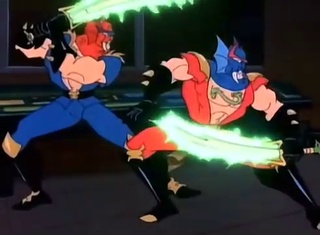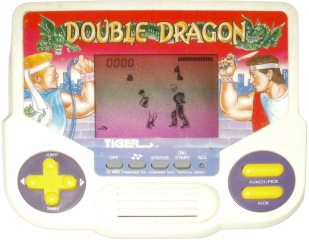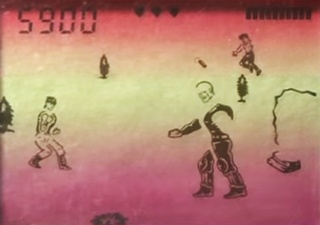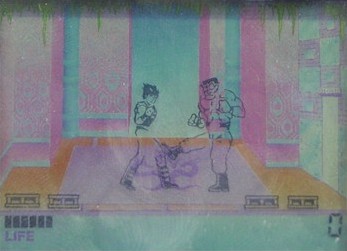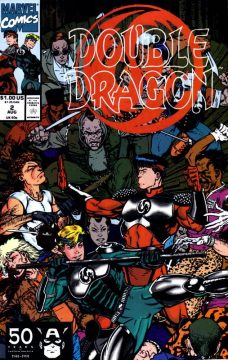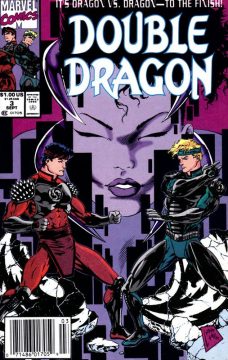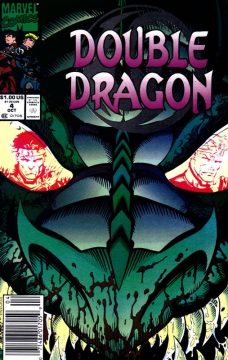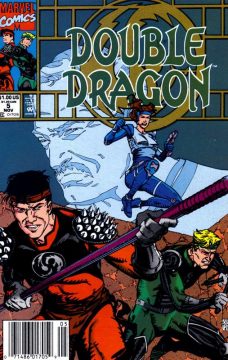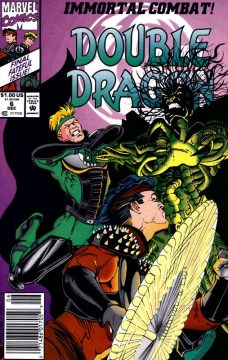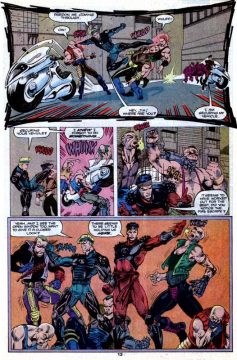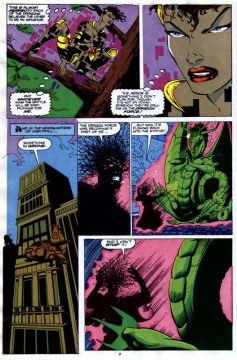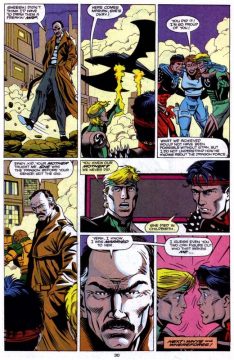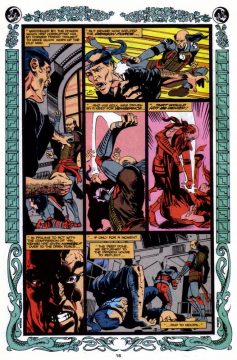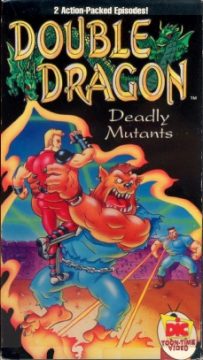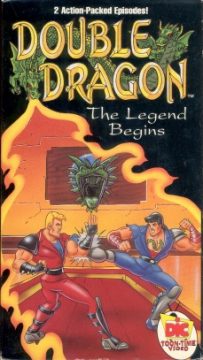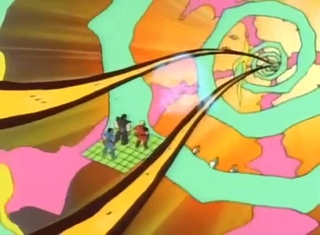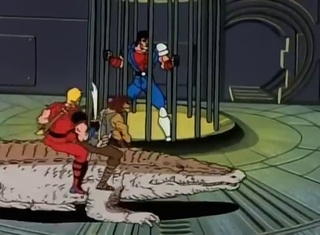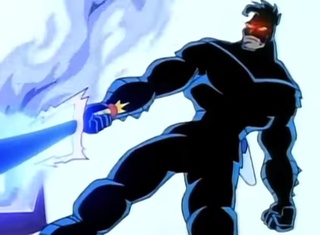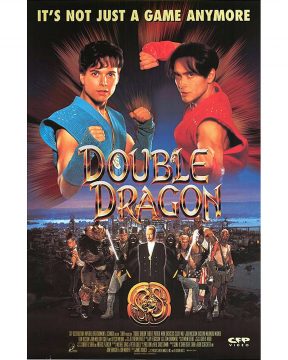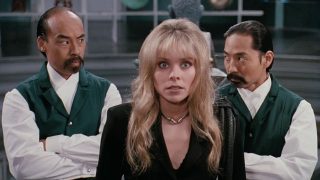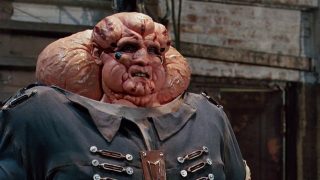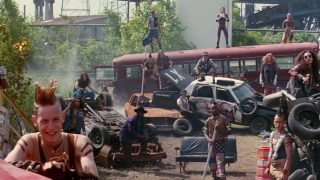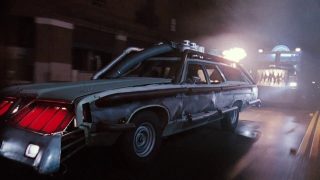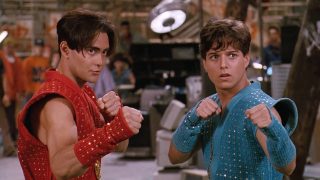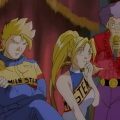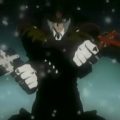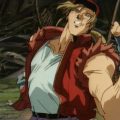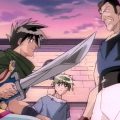- Double Dragon
- Double Dragon (NES / Game Boy)
- Double Dragon 2 (Arcade)
- Double Dragon II (NES/PCE)
- Double Dragon 3 (Arcade)
- Double Dragon III (NES)
- Double Dragon II (Game Boy)
- Super Double Dragon
- Double Dragon: The Revenge of Billy Lee
- Double Dragon V
- Double Dragon (Neo Geo)
- Rage of the Dragons
- Double Dragon Advance
- Double Dragon (Mobile)
- Double Dragon II: Wander of the Dragons
- Double Dragon (Zeebo)
- Abobo’s Big Adventure / Fighting of Double Dragon
- Double Dragon Neon
- Double Dragon IV
- Double Dragon: Other Media
Tiger LCD Games
If it’s a game and it was a hit in the late 1980s, chances are there’s a Tiger handheld of it. For Double Dragon, Tiger put out not just one LCD machine, but accompanied each game in the series up to Super Double Dragon with its own handheld, and even released a simplified wristwatch version of the first.
Tiger actually put some thought into translating the brawler experience into this very limited format: In the first game, Billy has to keep walking forward and punch and kick approaching enemies. He can do jump attacks and even dodge into the background in order to avoid nasty dynamite-throwing thugs that appear from the second stage onwards. The game even has a few changing background elements that imitate the four stages of the original.
Later games all used painted backgrounds underneath the LCD screen, which makes them look a little more colorful, but also more static than the original. The background dodging mechanic was ditched, replaced by the ability to kick backwards in defense against enemies that attack from behind. Super Double Dragon even has a button for a “Special Technique”. None of the games are particularly good, but it’s neat to see that some effort went into them.
(Double Dragon LCD handheld photo from Handheld Empire (modified); Super Double Dragon LCD handheld photo from Atari Age; Double Dragon LCD screenshot extracted from a video review by Classic Game Room; Double Dragon II and Double Dragon 3 LCD handheld photos from Handheld Museum.)
Double Dragon – Comic (1991)
In the early 1990s, US licensor Tradewest tried to turn Double Dragon into a big multimedia franchise, resulting in a wide range of tie-ins. Technōs wasn’t really involved with any of them, but there seems to have been some information flow in whatever direction – the Marvel comic book tie-in first introduced Marian as an undercover cop who was captured by the gang she was infiltrating – a plot point later found on the box of Return of Double Dragon.
In contrast to their output in high profile licenses like Star Wars, Marvel didn’t bother trying to step out of their comfort zone too far for Double Dragon. It is structured very much like a standard Marvel superhero story, complete with typical Marvel super villains – Superluminal is basically an evil Flash with his superhuman speed and the skin-tight spandex covering his entire body and face, Exoskeleton has huge mechanical arms strapped to his shoulders, and Stealth has fluctuating rectangular glitches float around her all but naked body that allow her to impersonate people and turn nearly invisible. The big bad, Nightfall, is a creepy shadow creature with seriously bad hair, who keeps people’s souls in a snow globe.
The setting overall is much more sci-fi than the Double Dragon games, with hoverboards, laser nunchucks, and cyborgs. Yet the Lee brothers have a stereotypical old traditional Chinese martial arts master who trains them (or is he Japanese? When he dies, his tombstone literally reads “SENSEI”). They have a huge dragon statue at their dojo, which grants them magical powers when they grab each other’s hand held up in the air, which gives them flashy armored costumes. This makes them so powerful that they can punch holes in a rock wall to use as climbing help.
Even though the Lee brothers are clearly as superhuman as their major enemies, they still need to deal with a lot of ordinary hoodlums, and the comic jumps through some weird hoops to include setpieces from the game, like the wooden bridge in the woods and the Evil Hideout with the familiar traps. There are some clever nods and even critical commentary on the game’s lore, like Billy and Jimmy always competing for Marian’s affection, to which she objects: “Are you guys nuts? I’m not some prize for you to fight over.” Later on, she even gets to kick ass herself, even though she still keeps getting abducted.
The six issues of the Double Dragon comic are a pretty dumb 90s thing that comes up with a lot of dumb jokes, dumb twists (guess who on Marvel’s staff had the same surname as the heroes and thus had to appear as their father?), dumb reasons for the brothers to fight each other, and a dumb grimdark tone. At least the art by Tom Raney (penciler) and Brad Vancarta (inker/colorist) is very detailed and imaginative, although the final two issues look strangely different and have slightly more garish coloring, almost as if they were finished up by someone else.
Double Dragon – Animated Series (September 12, 1993)
Next in line in Tradewest’s quest for world domination by means of Double Dragon was an animated series produced by DIC. It was just another garbage show produced for the sole purpose of trying to cash in with yet another boys’ toys line. So to make sure the action figures could come with a bunch of accessories, the Lee brothers fight with magical swords most of the time, which fuel their mystical dragon powers and also give them silly masks in a silly He-Man rip-off transformation sequence. They also have glowing dragon “birth marks” on their chests, which sometimes come alive for magical effects. Some new kind of fancy vehicle appears in almost every other episode in order to provide yet more toy pitches.
Taking a hint from the first NES game, Billy starts out on the evil side after being brainwashed from infanthood, but turns over to Billy surprisingly smoothly when the Shadow Master orders him killed after he fails the mission to retrieve the dragon sword. To show how evil he is, the big bad also quickly kills off the only two villains whose names present a nod to the video games – blue monster Abobo and “Wild Willy”, who is redesigned as a Texan gunslinger with a really offensively overdone accent. The Shadow Master never does this again in the rest of the series, even though all villains including himself keep failing over and over again, as dictated by the conventions of the genre. The two unfortunate examples are replaced by a whole range of typical toy line villains, with one exaggerated characteristic for each of them, emphasized by descriptive names such as Jawbreaker, Countdown, Icepick, Sickle, or Trigger Happy.
Overall the series would be mostly indistinguishable from other shows of its ilk if not for the familiar names. It checks off every box for this kind of programming – an overly descriptive theme song, sub-par animations, and the villains trying another unrelated scheme to forward their entirely nebulous evil ends and being defeated and humiliated every time because in 20th century television nothing was ever allowed to build up to anything meaningful. The Shadow Master has a delightfully calm and threatening voice at all times, but it’s undercut by the writing that puts him in the typical SatAM show buffoon villain position. Each episode ends with An Aesop Aesop delivered to the Dragons’ teenage students. A few of these are broken with no relation to the episode at hand, but often enough the show makes a valiant effort to actually present a suitable moral in the story, such as “don’t judge a person by their appearance, cause they might be secretly an interpol agent.” The cartoon takes on surprisingly serious subject matter for a hammy merchandise vehicle, including amputation (“I may only be half a man, but the half I got works good!”), or several fairly explicit instances of drug abuse. If Double Dragonis blessed by one fairly unique feature, it’s the “dragon of the week”: Every so often, the Lee brothers will be joined by new allies whom they turn into honorary dragons complete with their unique powers and silly costumes – more toy opportunities.
In the end, it seems the big merchandising dough was never rolled in. Even though the cartoon somehow made it to a second 13-episode season, the toy line must have tanked pretty hard. Apparently only three vehicles and seven figures were ever produced, which doesn’t even cover all of the most frequently recurring villains, let alone the Lee brothers’ upgraded armored versions from the later episodes, occasional allies, or Marian. It’s not a big loss – the toys were cheaply made to begin with, even when compared to similar franchises of the time.
Double Dragon – Movie (November 4, 1994)
After the comic books and TV series tried to squeeze the franchise into completely different niches, the Double Dragon life action movie is actually the media tie-in that stays the most faithful to the video games. Billy (Scott Wolf) and Jimmy (Mark Dacascos) are martial artists training together in a near future American metropolis run over by gangs – surprisingly not New York, but Los Angeles, probably because it was more convenient. It tries to incorporate several of the popular villains and the big bad Koga Shugo (Robert Patrick) can turn into a shadow to take over bodies like the final bosses in Double Dragon 2, complete with pretty cool effects for his shadowy appearance.
The film even has a few good ideas of its own, which give the film a stronger female presence than any other iteration of the franchise on top of that – Marian (Alyssa Milano) is the head of a rad vigilante group called the Power Corps (because no one could think of a more nineties name, apparently) and the Lees are trained by Satori Imada (Julia Nickson), who acts as the orphans’ badass mother figure (despite the actress being barely ten years older than the guys, but she gets a token grey streak in her hair to “establish” her wisdom).
Unfortunately, it also got a whole bunch of bad ideas. The plot is set in motion by a clichéd magical artifact – the Double Dragon amulet, which is split in two halves, one to give control over the body and the other to give control over the soul. What’s it with these media tie-ins always concocting supernatural sources for the Lee brothers’ abilities? The Teenage Mutant Ninja Turtles also left their omnipresent mark on this iteration of Double Dragon, so of course one of them (Billy) has to be an annoying good-for-nothing loudmouth who cannot actually do proper martial arts (saved his actor from learning any) and Jimmy the stoic perfectionist (so of course the Asian actor had to play him – the difference in race between the brothers is never even handwaved). Since TMNT had mutated drooling imbeciles for villains, Bo Abobo (yes, he gets a first name here) of course had to be a drooling imbecile who gets mutated into a monstrosity that looks like his head is stuck in between two enormous testicles. And of course the script is riddled with cool quips, slapstick moments and stupid pop culture references. (In a scene in a vandalized arcade, Jimmy kicks in the display shield of a Double Dragoncabinet – get it? It’s sooo meta!)
Worst of all, the plot hardly ever makes much sense and is full of scenes that seem to be just in there because someone figured it would seem cool. Satori gets to sacrifice herself for no good reason, just so the Lee brothers have someone to mourn over and are forced to figure out how to use the amulet by themselves – which just happens to work as the plot requires it, without them actually learning anything. During a speedboat chase, Billy and Jimmy crash into a highway sign, which astonishingly causes a huge explosion, but even more astonishingly leaves the two completely unscathed. Abobo’s mutated version is a total failure and much less threatening than his normal self, who was already supposed to have inhuman strength to begin with.
It doesn’t seem like anyone on set was ever sure what kind of future this would be, either – in one scene, two extras are seen arguing for access to an oxygen dispenser – despite everyone in the movie breathing freely without any hassle. It tries to be grim and dirty like The Warriors or Mad Max in one moment, then the next instance it’s as colorful and flashy as Back to the Future 2, with many stupid, impractical gadgets. The Lees drive a car with a rocket engine where they have to keep throwing in garbage for some reason to keep it running. When they manage to block the windshield of the truck chasing them, the villains switch on a camera module, which somehow offers them a top-down view in glorious ugly nineties CGI and turns the chase into a video game for them, complete with a joystick to control the car instead of the steering wheel.
What finally tips the whole thing over into utter ridiculousness is the terrible costume design for almost every character on screen. When Billy and Jimmy finally unlock the powers of the combined amulet, their clothes transform into garishly colored gis with sparkling dots all over them, and that’s just the tip of the iceberg of fashion failures. The costume design dates the film so painfully nineties, it might as well have gotten a crossover with Hackers if both movies hadn’t flopped so miserably. Over the course of its theatrical run, Double Dragon only made back a third of its budget.
